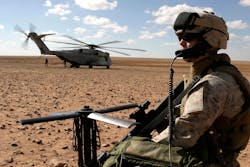Industry asked to build arrays of SWaP-constrained communications transceivers for long-range communications
ARLINGTON, Va. – U.S. military researchers are asking industry to provide long-range communications through mosaic antennas composed of spatially distributed low size, weight, power, and cost (SWaP-C) transceiver elements or tiles.
Officials of the U.S. Defense Advanced Research Projects Agency (DARPA) in Arlington, Va., issued a broad agency announcement (HR001120S0049) on Friday for the Resilient Networked Distributed Mosaic Communications (RN DMC).
The RN DMC program seeks to replace high-powered amplifiers and large directional antennas with mosaics of spatially dispersed tile transceivers.
Transmit power is to be distributed spatially among the tiles, while the system is to achieve gain through signal processing rather by use of a physical antenna aperture to concentrate energy.
Individual tiles could use radio frequency (RF) sounding to estimate channel responses and adjust transmit carrier phases to enable the distributed mosaic antenna to form directional beams and spatial nulls in desired directions.
DARPA will brief industry on the RN DMC program via an online Zoom meeting from 3:15 to 5 p.m. on Monday 22 June 2020.
Signal processing in the SWaP-optimized tiles enables these antennas to form directional beams that enhance signals and reject interference and enemy jamming.
The tiles could be on ground vehicles, infantry, unmanned aerial vehicles (UAVs), high altitude aircraft, or low-Earth-orbit satellites.
DARPA researchers say the mosaic approach would work with unmodified military tactical radios and waveforms, and be affordable enough to be expendable. It also can be secure and available only to authorized users.
Because spatial distribution allows for relatively low power from each tile, it is inherently low probability of detection compared to traditional transmitters. Furthermore, the approach will enable computing the relative position of each tile within a mosaic. Because there are several tiles involved that self-form into an array, the loss of individual tiles does not cause the entire array to fail.
In a traditional tactical communications system, a radio connects to a directional antenna through a physical cable or RF coupler. RN DMC, on the other hand, provides a physical communications connective layer that is independent of nearby tactical networks.
This approach also will provide the relative positions for each local tile a squad leader with a tactical radio and an Android Tactical Assault Kit (ATAK) or other visualization tool to track the locations of his or her squad members -- even in environments that deny use of the Global Positioning System (GPS).
Phase-one RN DMC performers will test long link capability in the laboratory, and in controlled outdoor long-range environments to validate the technology's ability to operate over at least 31 miles. The test will have at least two tactical radios; two ground tactical waveforms and one satellite communications (SATCOM) waveform; and 10 SWaP-optimized mosaic tiles.
Phase-two performers will refine their designs, and support a terrestrial test and a relay field test.
The terrestrial test will validate distributed-to-distributed coherent communications over a terrestrial link at least 0.6 miles long between two mosaic element antennas and will include static and moving user test cases.
This test will be for about 10 months. The mosaic antennas will have at least ten tiles each -- 20 tiles total -- and the system will be tested with at least two tactical radios and two terrestrial tactical waveforms. This test will demonstrate an Army use case where two squads separated by about a mile could communicate through RN DMC technology.
Related: Raytheon to replace obsolescent I/O circuit cards in Tomahawk missile communications system
A relay test exercise at the end of phase 2 will demonstrate a relay from a ground mosaic antenna to an airborne mosaic back down to a remote mosaic ground antenna about 62 miles away.
The third phase will involve adapting RN DMC technology to U.S. military service needs, and will demonstrate at a service-led field exercise. The end of the third phase will include service-specific systems ready for experimentation, design documents, and performance assessments; as well as a field exercise.
Companies interested should upload proposals no later than 4 Aug. 2020 to the DARPA BAA Website at https://baa.darpa.mil. Email questions or concerns to DARPA at [email protected].
More information is online at https://beta.sam.gov/opp/4a71282a1e0b44c59c57544365371438/view.
About the Author
John Keller
Editor-in-Chief
John Keller is the Editor-in-Chief, Military & Aerospace Electronics Magazine--provides extensive coverage and analysis of enabling electronics and optoelectronic technologies in military, space and commercial aviation applications. John has been a member of the Military & Aerospace Electronics staff since 1989 and chief editor since 1995.
